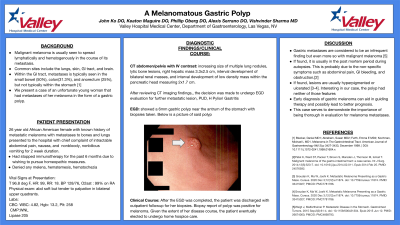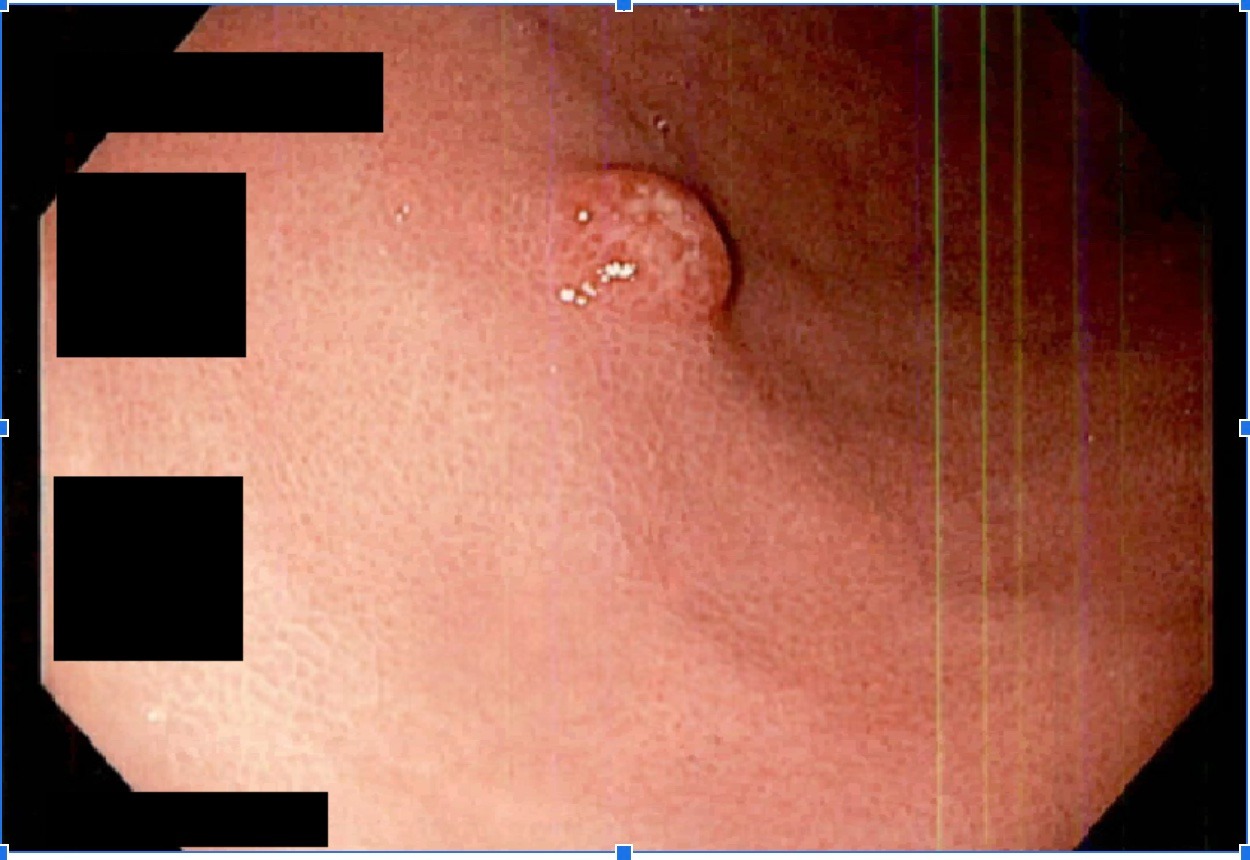Tuesday Poster Session
Category: Stomach
P4207 - A Melanomatous Gastric Polyp
Tuesday, October 24, 2023
10:30 AM - 4:00 PM PT
Location: Exhibit Hall

Has Audio

John Ko, DO
Valley Hospital Medical Center
Las Vegas, NV
Presenting Author(s)
John Ko, DO, Phillip Oberg, DO, Alexis Serrano, DO, Vishvinder Sharma, MD, Keaton Maguire, DO
Valley Hospital Medical Center, Las Vegas, NV
Introduction: Malignant melanoma typically spreads lymphatically and hematogenously to distant organs in its course of metastasis. Some of these common sites include the lungs, skin, brain, and the gastrointestinal (GI) tract. Within the GI tract, studies have shown that frequent sites for melanoma to metastasize to are the small bowel, colon, and anorectum. However, metastasis to the stomach is rare. We present an unusual case of an unfortunate young woman that had metastases of her melanoma in the form of a gastric polyp.
Case Description/Methods: 26-year old African American female with a known history of metastatic melanoma with metastases to bones and lungs presented to our hospital with the chief complaint of epigastric abdominal pain, nausea, and vomiting for 2 weeks. The patient was previously receiving immunotherapy but had stopped for the past 6 months because she wished to pursue more homeopathic measures. Physical exam demonstrated epigastric tenderness but vitals and laboratory studies were unremarkable. CT abdomen/pelvis with contrast demonstrated a 3.3 cm hepatic mass and a low density mass within the pancreatic head. Endoscopic evaluation for additional masses was performed and demonstrated a 7 mm normal appearing gastric polyp near the antrum. Biopsies were taken of the polyp and returned positive for metastatic malignant melanoma. Afterwards, the patient had subsequent improvement in her symptoms and was advised to follow up with her outpatient oncologist upon discharge.
Discussion: Gastric metastases are considered to be an infrequent finding in general but even more so in metastatic melanoma. When they are discovered, it is usually post mortem during autopsies. Delay in discovery may be in part due to symptoms being non-specific and can include findings such as abdominal pain, GI bleeding, and GI tract obstruction. When endoscopic evaluation has taken place, lesions are usually hyperpigmented or ulcerated. Interestingly, our patient had a normal appearing gastric polyp with no evidence of hyperpigmentation or ulceration. Treatment modalities for melanoma metastases include surgical resection, immunotherapy, and targeted therapy. Early diagnosis can aid in guiding therapy and lead to possible better prognosis. This case demonstrates the importance of being thorough in evaluation for metastases in Melanoma.

Disclosures:
John Ko, DO, Phillip Oberg, DO, Alexis Serrano, DO, Vishvinder Sharma, MD, Keaton Maguire, DO. P4207 - A Melanomatous Gastric Polyp, ACG 2023 Annual Scientific Meeting Abstracts. Vancouver, BC, Canada: American College of Gastroenterology.
Valley Hospital Medical Center, Las Vegas, NV
Introduction: Malignant melanoma typically spreads lymphatically and hematogenously to distant organs in its course of metastasis. Some of these common sites include the lungs, skin, brain, and the gastrointestinal (GI) tract. Within the GI tract, studies have shown that frequent sites for melanoma to metastasize to are the small bowel, colon, and anorectum. However, metastasis to the stomach is rare. We present an unusual case of an unfortunate young woman that had metastases of her melanoma in the form of a gastric polyp.
Case Description/Methods: 26-year old African American female with a known history of metastatic melanoma with metastases to bones and lungs presented to our hospital with the chief complaint of epigastric abdominal pain, nausea, and vomiting for 2 weeks. The patient was previously receiving immunotherapy but had stopped for the past 6 months because she wished to pursue more homeopathic measures. Physical exam demonstrated epigastric tenderness but vitals and laboratory studies were unremarkable. CT abdomen/pelvis with contrast demonstrated a 3.3 cm hepatic mass and a low density mass within the pancreatic head. Endoscopic evaluation for additional masses was performed and demonstrated a 7 mm normal appearing gastric polyp near the antrum. Biopsies were taken of the polyp and returned positive for metastatic malignant melanoma. Afterwards, the patient had subsequent improvement in her symptoms and was advised to follow up with her outpatient oncologist upon discharge.
Discussion: Gastric metastases are considered to be an infrequent finding in general but even more so in metastatic melanoma. When they are discovered, it is usually post mortem during autopsies. Delay in discovery may be in part due to symptoms being non-specific and can include findings such as abdominal pain, GI bleeding, and GI tract obstruction. When endoscopic evaluation has taken place, lesions are usually hyperpigmented or ulcerated. Interestingly, our patient had a normal appearing gastric polyp with no evidence of hyperpigmentation or ulceration. Treatment modalities for melanoma metastases include surgical resection, immunotherapy, and targeted therapy. Early diagnosis can aid in guiding therapy and lead to possible better prognosis. This case demonstrates the importance of being thorough in evaluation for metastases in Melanoma.

Figure: Gastric polyp visualized on EGD
Disclosures:
John Ko indicated no relevant financial relationships.
Phillip Oberg indicated no relevant financial relationships.
Alexis Serrano indicated no relevant financial relationships.
Vishvinder Sharma indicated no relevant financial relationships.
Keaton Maguire indicated no relevant financial relationships.
John Ko, DO, Phillip Oberg, DO, Alexis Serrano, DO, Vishvinder Sharma, MD, Keaton Maguire, DO. P4207 - A Melanomatous Gastric Polyp, ACG 2023 Annual Scientific Meeting Abstracts. Vancouver, BC, Canada: American College of Gastroenterology.
